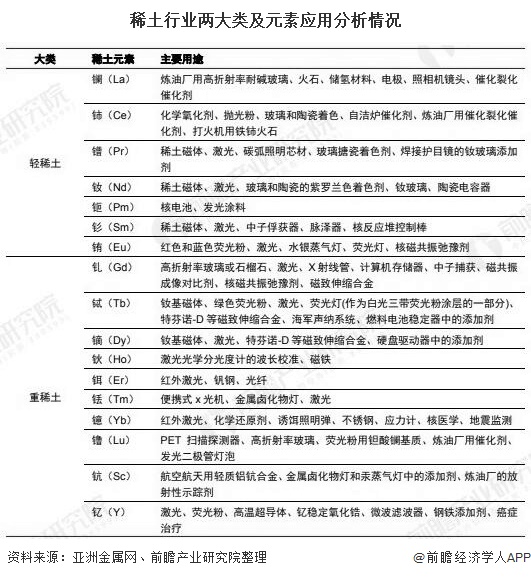
1. Rare earth is a non renewable resource with high global distribution and concentration
Rare earth is the general term of 17 metal elements in the chemical cycle table, including lanthanide, scandium and yttrium. Rare earth is usually divided into light and heavy rare earth groups, the former includes "lanthanum, cerium, praseodymium, neodymium, promethium, samarium and europium", the latter includes "gadolinium, terbium, dysprosium, holmium, erbium, thulium, ytterbium, lutetium, scandium and yttrium". There are more than 250 kinds of rare earth minerals in nature.
Two categories of rare earth industry and application analysis of elements
According to the data released by USGS, the total reserves of rare earth resources in the world are about 120 million tons, including 44 million tons in China, accounting for 37.8%; 22 million tons in Vietnam, accounting for 18.9%; 22 million tons in Brazil, accounting for 18.9%; 12 million tons in Russia, accounting for 37.8% 10.3%, the four countries account for nearly 80% of the total global reserves, with a high concentration of resource distribution.
Statistics of rare earth reserves in major countries in 2019
Distribution of rare earth reserves in major countries in 2019
2. China's rare earth reserves are highly concentrated, and Bayan Obo mine in Inner Mongolia dominates
Although China's rare earth minerals are distributed in six regions, including North China, Northeast China, East China, Central South China, Southwest China and Northwest China, they are mainly concentrated in the iron niobium and rare earth mining areas in Bayan Obo, Inner Mongolia, in North China. Their rare earth reserves account for more than 80% of the total rare earth reserves in China, and they are the main production bases of light rare earth in China.
On the other hand, China has a large reserve of rare earth mines and many associated rare earth deposits. China occupies two of the top three rare earth mines in the world, and its reserves are far higher than those of other countries. China's rare earth resources are heavy in the South and light in the north. Bayan Obo mine accounts for more than 80% of the total reserves of rare earth resources in China. It is the main production base of light rare earth resources in China.
Heavy rare earth is mainly distributed in the south, especially in the Nanling area. The ion adsorption type of medium rare earth and heavy rare earth ores are easy to mine and extract, which has become an important production base of medium and heavy rare earth in China. More than 2 / 3 of the hundreds of discovered ore producing areas are co associated minerals, which are of great value for comprehensive utilization.
Distribution of reserves in major production areas of rare earth resources in China
3. China's global leader in rare earth mining and smelting separation
After the Third Plenary Session of the Eleventh Central Committee, China's rare earth industry has entered a period of vigorous development. Led by Xu Guangxian, the experts of rare earth have put forward the theory of cascade extraction, and completed the experiment of complete separation of light and heavy rare earth in 1982, which greatly promoted the development of rare earth extraction and separation technology in Baotou mine. At the end of 1970s, China's rare earth production was about 1000 tons, and the products were mainly primary products. In 1988, China's rare earth production reached nearly 30000 tons, surpassing the U.S. historical maximum production in 1984, becoming the world's first rare earth producer. Since then, China's rare earth smelting and separation level has been leading in the world and continues to control the global market of high-purity single rare earth.
China's rare earth smelting capacity is the world leader. According to the data of Rare Earth Industry Association, it decreased to 105000 tons in 2016, but still accounts for 88.2% of the world. In 2016, Malaysia's smelting capacity was 11900 tons, while the U.S. smelting capacity was closed. China almost "monopolized" the production and smelting capacity of global rare earth metal mines.
According to the data released by USGS, in 2019, the global rare earth mine output will be 210000 tons, of which China's rare earth mine output will be 132000 tons, accounting for nearly 63%, making it the world's largest rare earth mine producer; the U.S. rare earth mine output will be 26000 tons, making it the first producer outside China; Followed by Burma (22 thousand tons), Australia (21 thousand tons), India (3000 tons), Russia (2700 tons), Madagascar (2000 tons), Thailand (1800 tons), Brazil (1000 tons), Vietnam (900 tons), Burundi (600 tons).
Statistics of the proportion of China's rare earth production to global total production in 2010-2019
4. Analysis on the future development trend of China's rare earth industry
Global and Chinese rare earth production is expected to decline. Global and China's rare earth production has basically maintained an upward trend from 1998 to 2014, basically maintained a downward trend from 2014 to 2017, and rose in 2018. In recent years, with more and more attention paid to the strategic value of rare earth, the Chinese government has also taken measures for blind mining and uncontrolled mining of rare earth, strictly limiting the production and superimposing the impact of the epidemic. It is expected that the production will decline in the next two years.
1、稀土是不可再生资源,全球分布集中度高
稀土是化学周期表中镧系元素和钪、钇共十七种金属元素的总称。稀土通常分为轻、重稀土两组,前者包括“镧、铈、镨、钕、钷、钐、铕”,后者包括“钆、铽、镝、钬、铒、铥、镱、镥、钪、钇”,自然界中共有 250 余种稀土矿。

根据美国地质调查局(USGS)公布数据显示,全球稀土资源总储量约为1.2亿吨,其中中国储量为4400万吨,占比约37.8%,越南储量2200万吨,占比约为18.9%,巴西储量2200万吨,占比18.9%,俄罗斯储量1200万吨,占比 10.3%,四国合计占全球总储量的近八成,资源分布集中度较高。


2、中国稀土储量分布高度集中,内蒙古白云鄂博矿占据主导
中国稀土矿产虽然在华北、东北、华东、中南、西南、西北等六大区均有分布,但主要集中在华北区的内蒙古白云鄂博铁-铌、稀土矿区,其稀土储量占全国稀土总储量的80%以上,是中国轻稀土主要生产基地。
另一方面,中国稀土矿山储量大,共伴生稀土矿床多。中国在全球前三大稀土矿山中就占据两席,并且储量远超其他国家矿山。我国稀土具有南重北轻的特点,其中白云鄂博矿储量占全国稀土总储量的 80%以上,是中国轻稀土主要生产基地。
重稀土则主要分布在南方地区,尤其是在南岭地区,分布的离子吸附型中稀土、重稀土矿,易采、易提取,已成为中国重要的中、重稀土生产基地。在已发现的数百处矿产地中,2/3以上为共伴生矿产,综合利用价值较大。

3、中国稀土矿开采及冶炼分离水平全球领先
十一届三中全会以后,我国稀土工业进入了蓬勃发展时期,以徐光宪为首的稀土专家们提出了串级萃取理论,并于1982年完成轻重稀土全分离试验,极大促进了包头矿稀土萃取分离工艺的发展。上世纪70年代末,我国稀土产量约1000吨,且产品主要是初级品,1988年我国稀土产量达到近3万吨,超过美国1984年的历史最高产量,成为世界第一稀土生产国,自此我国稀土冶炼分离水平全球领先并延续至今,控制了高纯单一稀土的全球市场。
中国稀土冶炼能力全球领先,根据稀土行业协会数据,2016年有所降低,为10.5万吨,但占全球比重仍高达88.2%,2016年马来西亚冶炼能力为1.19万吨,美国的冶炼能力则全部关闭,中国几乎“垄断”全球稀土金属矿山生产和冶炼能力。
根据USGS公布数据显示,2019年全球稀土矿产量21万吨,其中,中国稀土矿产量13.2万吨,占比近63%,是世界最大稀土矿生产国;美国稀土矿产量2.6万吨,为中国境外第一生产国;其次是缅甸(2.2万吨),澳大利亚(2.1万吨),印度(3000吨),俄罗斯(2700吨),马达加斯加(2000吨),泰国(1800吨),巴西(1000吨),越南(900吨),布隆迪(600吨)。

4、中国稀土行业未来发展走势分析
全球与中国稀土产量预计将趋势下行。全球及中国稀土产量自 1998年以来至 2014年基本保持上升趋势,2014年至2017基本维持下滑态势,2018年出现上涨。近年来随着稀土战略价值越来越受到重视,中国政府也对盲目开采、无节制开采稀土采取措施,严格限制产量,叠加疫情影响,预计未来两年产量将呈下降趋势。
